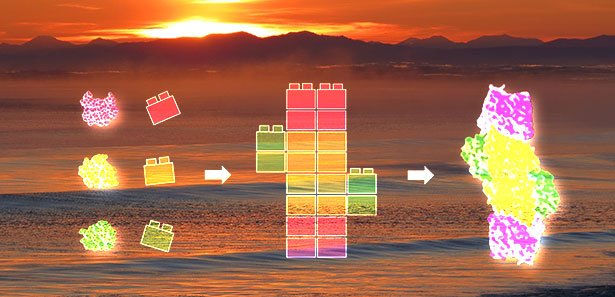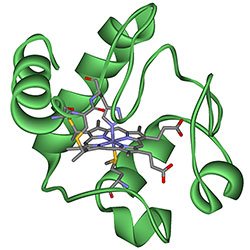Four protein modules contained in the very first cells
Already active in the primordial soup: researchers have identified four protein structures that are as old as life itself. These four basic building blocks probably helped the very first cells to generate energy. In the course of evolution, these 'Lego bricks' of life were then combined into innumerable protein variants, which are still working in humans and all other organisms, as the scientists explain.

Today's protein diversity is derived from the simple protein building blocks of the very first cells. Four of these building blocks have now been identified by researchers. © Vikas Nanda/ Rutgers University HG: PixabayProteins are the engines of all life. Thousands of variants of these amino acid molecules work in the cells of all organisms and form the basis for the complex machinery of life. But what was at the beginning of this diversity? Which proteins or protein building blocks formed the basis for the very first cells more than three billion years ago?
Hunt for the primeval proteins
Unfortunately, there are fossils that show us what the proteins looked like at the beginning of life, explains Vikas Nanda from Rutgers University. That's why we have to start from what we have today and work our way back, so to speak.
According to common belief, at least some of the original proteins must have belonged to the group of oxidoreductases - proteins with transition metals as cofactors that catalyse electron transfer and are therefore decisive for the energy production of the original cells.
In order to trace the original proteins, the researchers used a computer program that analyzed the three-dimensional structure of just under 10,000 proteins according to common - and thus presumably very original - molecular parts.
This is the first time that we have broken down molecules from thousands of amino acids into parts that could be of primordial origin, according to Nanda.
Four modules and a lot of combinations

The small protein cytochrome C, which is important for photosynthesis, may have already existed in the very first cells. © public domainAnd the search was successful: The scientists discovered four protein building blocks that repeatedly appeared in a wide variety of proteins and played a decisive role in energy transfer. These are bacterial ferredoxin, the enzymes cytochrome C and symerythrin as well as a variant of the copper-containing protein plastocyanin - an important enzyme for the photosynthesis of algae.
These four structural modules are in principle nothing more than remnants of the original 'building blocks of life', Nanda and his colleagues explain. These molecular nanomachines have always been passed on in the course of evolution with only minor changes.
Like lego bricks, these proteins were put together in increasingly different combinations and thus formed the basis of an ever-growing family of essential building blocks of life.
There could be more
But as the researchers emphasize, these four Lego bricks of life are probably not the only ones that were active in the first cells. They suspect that they will be able to identify another five to ten primary proteins by further searches. Another challenge is to find out how these primordial proteins have evolved over the course of evolution - in other words, to reconstruct their family tree.
However, the new findings could also have a very practical benefit:
If we understand these modules and how they are connected within the existing proteins, this could help us to develop completely new catalysts, said Nanda's colleague Paul Falkowski. With them, it would be easier to divide water, bind nitrogen and do other things that would be useful to our society.
Source: Proceedings of the National Academy of Sciences, 2018; pnas. 1714225115

wow amazing knowledge about scientific things really a very knowledgeable... after a long time i had opportunity to see your post on it , really glad keep it up @n3blu4
Hey there, I was very busy the last weeks. Christmas times, New Years Eve and a lot of birthday parties... Couldn't find the time to write any articles...
yes must be i can understand glad too see you back ☺ keep updating. .
wow amazing information never was thought about it all but you make me think science is so mysterious and have alot of to learn and revel great post @n3blu4
Thank you! I am glad you like my artice. Stay tuned for more to come...
What an amazing post..I have read some the thing you have wrote but not all of them..Loved the knowledge that you are sharing with us..Glad to see it..@n3blul4
Thanks!
that's an amazing knowledge you giving us by your post it's really need alot of effort and homework to write all this up, you have really great talent keep it up bro .
Thank you! I'll try to do my best.
it's amazing never was known so deep about the cells and got to know by your post teally an amazing knowledge and i really like science and followed you for it ☺ @n3blu4
I am glad you like my article. Thank you for following and stay tuned for more...
This post has received a 0.77 % upvote from @booster thanks to: @n3bul4.
Congratulations! This post has been upvoted from the communal account, @minnowsupport, by n3bul4 from the Minnow Support Project. It's a witness project run by aggroed, ausbitbank, teamsteem, theprophet0, someguy123, neoxian, followbtcnews, and netuoso. The goal is to help Steemit grow by supporting Minnows. Please find us at the Peace, Abundance, and Liberty Network (PALnet) Discord Channel. It's a completely public and open space to all members of the Steemit community who voluntarily choose to be there.
If you would like to delegate to the Minnow Support Project you can do so by clicking on the following links: 50SP, 100SP, 250SP, 500SP, 1000SP, 5000SP.
Be sure to leave at least 50SP undelegated on your account.
Awesome article dude interesting information about scientific things...keep it up great post :)